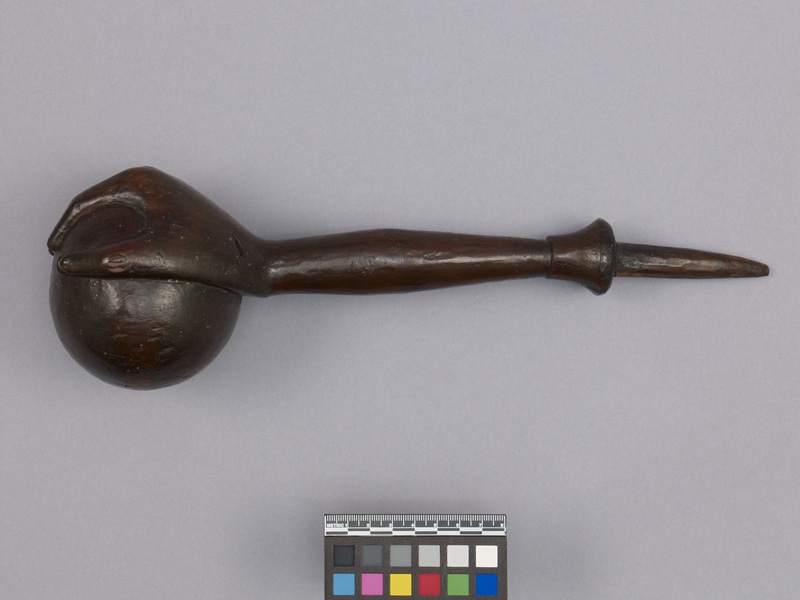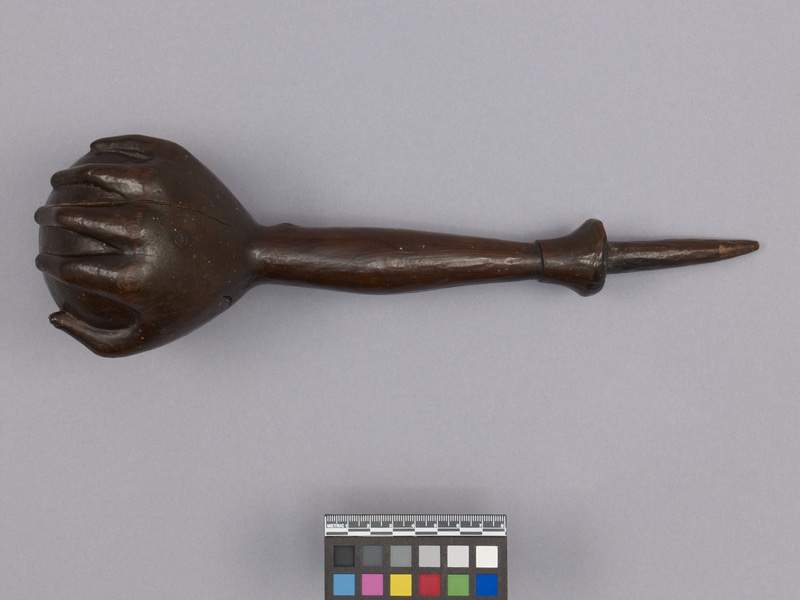Club Item Number: 2945/1 from the MOA: University of British Columbia




Description
Club of dark brown coloured yew wood carved in the shape of a hand grasping a sphere, the carved wrist and arm extending into a narrow handle that ends in a sharp point. The surface of the wood has a shiny patina.
History Of Use
Possibly a chief's ceremonial club (ḥawʼiɬmis), or possibly a fish or sea mammal club (ʔacḥyʼakw). For comparable Northwest Coast clubs with a ball-and-hand style carving, see 2791/9, A4115, A4379, and A6134.
Specific Techniques
UBC Forest Sciences Centre confirmed in 2014 that the club is carved from yew wood (Taxus), most likely Pacific yew (Taxus brevifolia).
Narrative
The club’s comparatively detailed rendering of knuckles, fingertips, and wrist bone, as well as its almost perfectly rounded sphere, shares a stylistic sensibility with Nuu-chah-nulth masks, rattles, and other carvings of similar age. Thought to have been collected in 1778 during Captain James Cook's third voyage to the Pacific (1776-1780), from Nuu-chah-nulth people in Yuquot (Friendly Cove, Nootka Sound), on the West coast of Vancouver Island. The club passed through a number of English private collections from 1783 to 1967, at which point it was sold at auction in London, ending up in a New York collection. In 2012 the Audain Foundation for the Visual Arts donated the funds for MOA to purchase the club from a New York auction, for display in its permanent collection.
Item History
- Made in Vancouver Island, British Columbia, Canada before 1778
- Collected in Yuquot, British Columbia, Canada during 1778
- Owned by Donald Ellis Gallery before March 9, 2012
- Received from Donald Ellis Gallery (Seller) and Audain Foundation for the Visual Arts (Funding source) on March 9, 2012
What
Who
- Culture
- Nuu-chah-nulth: Mowachaht ?
- Previous Owner
- Donald Ellis Gallery
- Received from
- Donald Ellis Gallery (Seller) and Audain Foundation for the Visual Arts (Funding source)
Where
- Holding Institution
- MOA: University of British Columbia
- Made in
- Vancouver Island, British Columbia, Canada
- Collected in
- Yuquot, British Columbia, Canada
When
- Creation Date
- before 1778
- Collection Date
- during 1778
- Ownership Date
- before March 9, 2012
- Acquisition Date
- on March 9, 2012
Other
- Condition
- good
- Accession Number
- 2945/0001